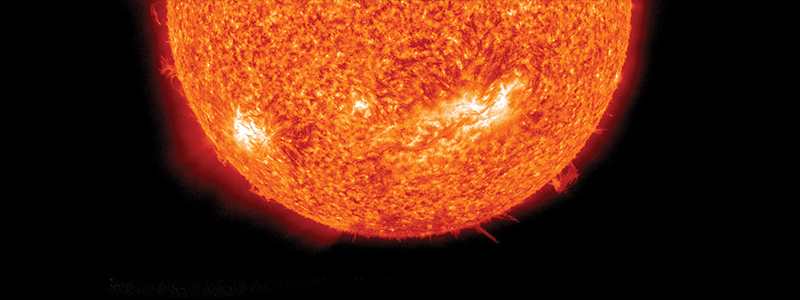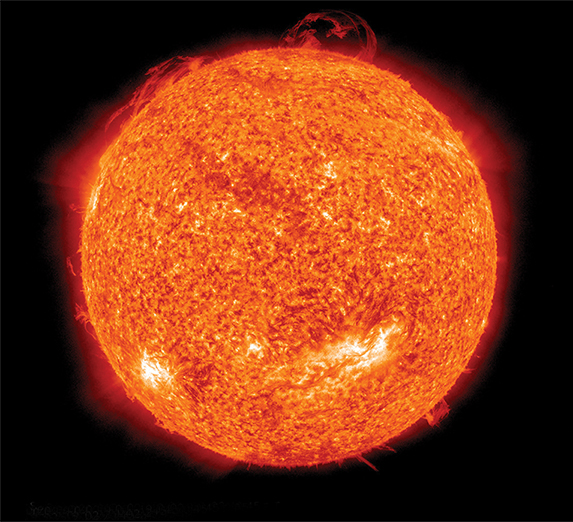
Software Innovations Speed Scientific Computing
NASA Technology
What causes the Sun to change? And what are the impacts on our planet and our daily lives?
These are some of the top questions that the Heliophysics Division of NASA’s Science Mission Directorate is seeking answers to through a variety of missions to study the Sun. The most recent, the Solar Dynamics Observatory (SDO), launched in 2010, beams back 150 million bits of data per second—almost 50 times more science data than any other mission in NASA history. As a result, SDO’s instruments are giving solar scientists an unprecedented look at the Sun.
On a similar mission, NASA’s Reuven Ramaty High Energy Solar Spectroscope Imager (RHESSI) launched in 2002 to gather a wealth of data to construct images of the Sun. To create meaningful visualizations out of the vast data, much of it has been deciphered using a computer programming language called Interactive Data Language (IDL). In addition to studying the Sun, there is widespread use of IDL throughout NASA to process data, analyze images, perform computations, and make simulation models.
As NASA missions continue to produce an increased amount of data, and as computational procedures become increasingly complex, NASA requires ever greater computing power.
Partnership
To help reduce the time needed to analyze data from missions like those studying the Sun, Goddard Space Flight Center awarded a Small Business Innovation Research (SBIR) contract in 2004 to Tech-X Corporation of Boulder, Colorado.
Through Phase I and II SBIRs, Tech-X demonstrated software capable of running IDL applications on linked computers, or cluster systems. The computers worked together to form a single system, without requiring significant modification to the original program.
By enabling IDL to work on clusters, Tech-X created a technology that increased performance in a familiar programming environment for NASA scientists, while reducing the time needed to analyze large amounts of data. Today, this software is available in Tech-X’s commercial product called FastDL.
After the demonstration of FastDL for NASA, something unexpected happened. “Toward the end of the Phase II SBIR, we started to redirect the proposal to investigate the usability of graphics processing units to help scientists accelerate their data analysis tasks,” explains Peter Messmer, vice president of the space applications group at Tech-X. “That was the beginning of the GPULib product that we are now offering at Tech-X.”
At the time, graphics processing units (GPUs) were mainly used for 3D gaming graphics, but the technology was becoming more commonly used to accelerate scientific computing. Messmer says Tech-X wanted to use one piece of hardware—a GPU—rather than several pieces, to make the computations faster.
Today, Tech-X attributes the initial development of GPULib, which makes available a library of mathematical functions to facilitate the use of GPUs for scientific computing, to its work with NASA. “There are very innovative people on the Agency side who see the potential of technologies and, in collaboration with small businesses, can make leading-edge technologies happen,” says Messmer.
Benefits
By 2008, NASA scientists were using Tech-X’s parallel computing tools to process large quantities of visual data from the RHESSI mission 10–40 times faster than they could previously. In applying FastDL to NASA’s Solar and Heliospheric Observatory, Tech-X processed data more than seven times faster on a cluster of 12 processors.
Over the past 5 years, government contracts and products including FastDL and GPULib have helped the company to double its number of headquarters employees to 70. Commercially available for 6 years, FastDL has earned about $90,000 in revenue for Tech-X. GPULib, available for 2 years, has earned about $100,000 in revenue.
Messmer says that what makes these products so unique is that they target IDL, which is widely used by engineers, scientists, analysts, and other technical professionals in satellite, medical, and astrophysical imaging.
Using FastDL, scientists and developers can run IDL visualization and analyses applications using several computers at once to shorten the time required to get results. Because not every visualization and analysis problem can be solved using the same parallel computing paradigm, FastDL includes two components: TaskDL (for independent computations) and mpiDL (for interdependent computations).
The other NASA-derived product, GPULib, supplies a mathematical library that simplifies access to parallel computing on a GPU. It brings high-performance numerical operations to everyday desktop computers with an easy-to-use interface. According to Tech-X, the time it takes for implementations of common mathematical operations is 5–40 times faster using the technology.
Available under two licensing arrangements, Messmer says there have been close to 10,000 downloads of GPULib from Tech-X’s website.
Scientists in a variety of fields can benefit from the increased execution speed allowed by GPULib in application areas such as structural and fluid mechanics, Earth sciences, biosciences, medical and diagnostic imaging, and financial engineering. Current applications for simulation and modeling include computational fluid dynamics, tsunami modeling, galaxy formation, and neural-tissue simulations. In data analysis, applications include image enhancement, deblurring, real-time image processing, hyperspectral imaging, astronomical imaging, medical imaging, and seismic data processing.
At the Department of Radiation Oncology at Loyola University in Maywood, Illinois, the software is used for aligning patients on a treatment table before and after X-ray imaging, a computationally-demanding application that needs to be performed quickly. John Roeske, Director of Radiation Physics at the university, says, “Ordinarily, the approach would take 5–10 seconds. Using the GPULib we feel we can get the alignment to better than a second.”
Alongside medical imaging, Tech-X is focusing on providing custom products for applications in remote sensing and gaming. “The future as we see it is to provide domain-specific programs for different applications,” says Messmer.
What will come next? And what are the impacts on processing speed?
These are some of the top questions that Tech-X is seeking answers to through additional SBIRs with NASA to reveal more about Earth and the universe.
employees to 70 and generated about $190,000 in revenue from its NASA-derived products.

NASA requires increased computing power to process images like this one of the Sun, created by the Solar Dynamics Observatory in September of 2010.














